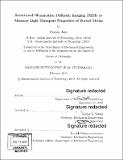| dc.contributor.advisor | Sanjay E. Sarma. | en_US |
| dc.contributor.author | Jain, Pranay. | en_US |
| dc.contributor.other | Massachusetts Institute of Technology. Department of Mechanical Engineering. | en_US |
| dc.date.accessioned | 2019-10-11T21:53:49Z | |
| dc.date.available | 2019-10-11T21:53:49Z | |
| dc.date.copyright | 2019 | en_US |
| dc.date.issued | 2019 | en_US |
| dc.identifier.uri | https://hdl.handle.net/1721.1/122509 | |
| dc.description | Thesis: Ph. D., Massachusetts Institute of Technology, Department of Mechanical Engineering, 2019 | en_US |
| dc.description | Cataloged from PDF version of thesis. | en_US |
| dc.description | Includes bibliographical references (pages 175-179). | en_US |
| dc.description.abstract | We come across colloidal dispersions frequently in our daily lives. Food substances like milk and cheese, cosmetic products like lotions and shampoos, and even biological materials like skin tissue are a few examples of colloidal dispersions. One common property of these dispersions is that they are neither entirely opaque nor transparent to light. Light diffuses in these media due to scattering and absorption by particles or other microscopic inhomogeneities. Measuring the light transport properties of colloidal dispersions is essential for several applications. In milk, this allows us to estimate the size distribution and concentrations of suspended fats and proteins. In dispersions like moisturizers and paints, it lets us estimate consistency and colloidal stability. In the case of skin, it helps us distinguish and characterize internal structures and pigments, giving information vital for skin-related conditions like melanoma, lesions and burns. | en_US |
| dc.description.abstract | Among known techniques to measure the optical scattering and absorption properties, imaging-based methods are particularly interesting. Imaging can work with relatively simple hardware, offloading much of the burden to software and computation. Image sensors provide a rich set of data, millions of independent pixels, per observation. However, they suffer from lower dynamic range compared to other photodetectors. Existing imaging-based methods either struggle to work in low dynamic ranges or are inefficient in retrieving information, precluding real-time measurements. For imaging to be effective, it is essential to devise methods that address these concerns. In this thesis, we introduce Structured Illumination Diffusion Imaging (SIDI), a method to analyze turbid media and quantify its light transport properties. The goal is to extract maximum information per captured image and utilize image sensor resources efficiently. | en_US |
| dc.description.abstract | In SIDI, we project broadband spatial patterns as structured illumination on a turbid sample and image the diffuse backscatter. We then compute the power spectra of the input and output random processes using a windowing-based spectral estimation algorithm. Comparing the spectra gives an estimate of the medium's spatial frequency response. We fit a parametric optical diffusion model to the response to quantify the light transport properties. For demonstration, we choose to project laser speckle patterns as a simple, versatile and scalable source of random structured illumination. Speckles serve as realizations of a broadband random process suitable for analyzing turbid media like milk and skin. We use an off-the-shelf CMOS camera to image the diffuse backscatter. For validation, we present the results of a benchmarking study using standard liquid tissue phantoms as sample turbid media. | en_US |
| dc.description.abstract | We estimate the light transport properties using SIDI and compare them with known values from literature. The research is directed towards developing a fundamental technology that can eventually be adapted to a variety of commercial applications. We discuss multiple proposed applications including milk fat and protein measurements, inline quality control of paints, moisturizers and food products, and skin imaging for medical diagnostics. To validate the first among these applications, we present the results of a study with raw milk samples as turbid media. SIDI is able to distinguish and quantify fats and proteins based on their size contrast and different scattering regimes. | en_US |
| dc.description.statementofresponsibility | by Pranay Jain. | en_US |
| dc.format.extent | 179 pages | en_US |
| dc.language.iso | eng | en_US |
| dc.publisher | Massachusetts Institute of Technology | en_US |
| dc.rights | MIT theses are protected by copyright. They may be viewed, downloaded, or printed from this source but further reproduction or distribution in any format is prohibited without written permission. | en_US |
| dc.rights.uri | http://dspace.mit.edu/handle/1721.1/7582 | en_US |
| dc.subject | Mechanical Engineering. | en_US |
| dc.title | Structured Illumination Diffusion Imaging (SIDI) to measure light transport properties of turbid media | en_US |
| dc.title.alternative | SIDI to measure light transport properties of turbid media | en_US |
| dc.type | Thesis | en_US |
| dc.description.degree | Ph. D. | en_US |
| dc.contributor.department | Massachusetts Institute of Technology. Department of Mechanical Engineering | en_US |
| dc.identifier.oclc | 1121202926 | en_US |
| dc.description.collection | Ph.D. Massachusetts Institute of Technology, Department of Mechanical Engineering | en_US |
| dspace.imported | 2019-10-11T21:53:49Z | en_US |
| mit.thesis.degree | Doctoral | en_US |
| mit.thesis.department | MechE | en_US |
